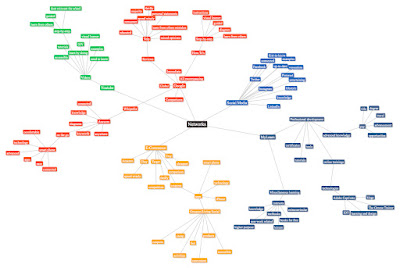 |
Mind Map of Learning Networks - Dennis Greene
Connectivism, as Davis, Edmunds and Kelly-Bateman quoted George Siemens as describing it, "is driven by the understanding that decisions are based on rapidly altering foundations. New information is continually being acquired and the ability to draw distinctions between important and unimportant information is vital" (2008). At the core of connectivism is the importance of networks and the powerful role that they play on an individuals ability to learn and experience something new. Because of the drastic change in technology and its utilization to obtain new knowledge, one cannot rely solely on their personal experience and must seek out other people, technology, social structures, systems and power grids to share and obtain information (Davis, Edmunds, Kelly-Bateman, 2008). With that being said, I have provided a glimpse into some of my own learning networks and the ways in which I use them as a learner to gather and apply information.
Looking at the map of my networks, you will see that I use different resources for different functions. The most common way in which I use my networks is to seek out unknown information. Using sites like YouTube, Google, Yelp, and Wikipedia I am able to quickly and easily access information that would have otherwise remained unknown to me. YouTube for example has become a staple in my search to learn on my own. YouTube is a valuable resource for me due to being a visual learner. The ability to watch and do is very beneficial to me and allows for a demonstration of knowledge that I can then practice, apply, and retain. Recently I wanted to create a document for my team that would allow them to quickly and neatly organize updates to our senior leadership. I didn't want the document to be a basic word documents so I googled information on the developer functions within word and then sought out YouTube videos to guide me through the functions. From there, I created the document and did additional explorations through trial and error to perfect the way I wanted it to look and be used. It has since been implemented and used on a weekly basis for communication with senior leadership. As you can see, I used several different networks in this resource to learn and implement new information (Google, Microsoft, and YouTube).
My network also provides necessary information when I have questions or need information about a particular subject, topic, or even item. As you can see from my mind map, I like to shop and in order to be an effective shopper I need to be informed about the products. One of the principles of connectivism is that "decision-making is itself a learning process" (Davis, Edmunds, Kelly-Bateman, 2008). Siemens stated that "the capacity to know is more critical than what is actually known. Knowing where to find information is more important than knowing information" (Siemens, 2008, para. 6). Generally when I am considering making a purchase, I will google the particular item to learn more about it. From there, I will read reviews about the product from people who have previously purchased that item. Once I have determined that the item is suitable for purchase, or I have selected a comparable item I will begin to compare prices from different vendors. As I narrow down the cheapest sellers, I will then start to search for coupons or promotions. I will conduct another search for possible discounts using a different set of resources and sites. Once I have determined all possible outcomes, I make an informed purchase. Without the use of my networks and the advantages of technology, this wouldn't be possible.
Considering the basic tenets of Connectivism, which Siemens outlines as chaos theory, networks, and interplay of complexity and self-organization (Davis, Edmunds, Kelly-Bateman, 2008), my particular network supports the ideas of the connectivism learning theory. Due to the abundance of information and resources available to me as a learner, it is essential to utilize a network of people and rich technologies that allow for the acquisition and application of knowledge. With my previous example of online shopping, the interconnectedness of several products, networks, resources, opinions and technologies lent themselves to my acquisition of knowledge and product. My example of YouTube being integral to my learning style supports what Siemens described as the importance of visualization within academia (Laureate Education, n.d). Being able to visualize the learning and connect the understanding for my own purposes drives a greater sense of cognitive understanding and future application. Furthermore, as I learn skills and techniques I share that information with others and disseminate the knowledge creating another network of learning and sharing. Connectivism addresses the nature of abundant information, use of technology, and increasingly complex environments that learners interact with to form understanding and gain knowledge. My network of learning resources fully support a connectivist environment by which I use technology to access vast resources for information to make decisions and prepare to apply those understanding to the complex environment that is constantly changing and altering as new information is acquired.
Resources:
Davis, C., Edmunds, E., & Kelly-Bateman, V. (2008). Connectivism. In M. Orey (Ed.), Emerging perspectives on learning, teaching, and technology. Retrieved from http://projects.coe.uga.edu/epltt/index.php?title=Connectivism
Siemens, G. (2008). About: Description of connectivism. Connectivism: A learning theory for today’s learner, website. Retrieved from http://www.connectivism.ca/about.html
No comments:
Post a Comment